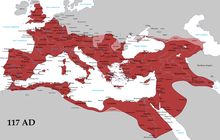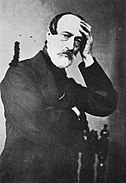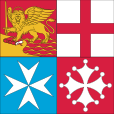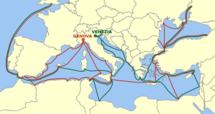Italy - Introduction
Italy (officially: Italian Republic) is a country in Europe, precisely in Southern Europe, with a population of about 58.7 Millions inhabitants today (2024-06-22). The capital city of Italian Republic is Rome, and the official country TLD code is .it. Italy has cca2, cca3, cioc, ccn3 codes as IT, ITA, ITA, 380 respectively. Check some other vital information below.

Italy , Coat of Arms
Names
| Common | Italy |
|---|---|
| Official | Italian Republic |
| Common (Native) | Italy |
| Official (Native) | Italian Republic |
| Alternative spellings | IT, Italian Republic, Repubblica italiana |
| Translations ⬇️ | |
Languages
| ita | Italian |
|---|
Geography

Italy is located in Southern Europe and has a total land area of 301336 km². It is bounded by Austria, France, San Marino, Slovenia, Switzerland, Vatican City and the capital city is Rome
| Region/Continent | Europe |
|---|---|
| Subregion | Southern Europe |
| TimeZone | UTC+01:00 |
| Capital city | Rome |
| Area | 301336 km² |
| Population 2024-06-22 | 58.7 Millions |
| Bordered Countreies | Austria, France, San Marino, Slovenia, Switzerland, Vatican City |
| Demonym | |
| eng | Male: Italian / Female: Italian |
| fra | Male: Italien / Female: Italienne |
| Lat/Lng | 42.83333333, 12.83333333 |
Historical data and more

The National Flag of Italy
The flag of Italy is composed of three equal vertical bands of green, white and red.
Historyedit
Prehistory and antiquityedit
Lower Paleolithic artefacts, dating back 850,000 years, have been recovered from Monte Poggiolo. Excavations throughout Italy revealed a Neanderthal presence in the Middle Palaeolithic period 200,000 years ago, while modern humans appeared about 40,000 years ago at Riparo Mochi.
The ancient peoples of pre-Roman Italy were Indo-European, specifically the Italic peoples. The main historic peoples of possible non-Indo-European or pre-Indo-European heritage include the Etruscans, the Elymians and Sicani of Sicily, and the prehistoric Sardinians, who gave birth to the Nuragic civilisation. Other ancient populations include the Rhaetian people and Camunni; known for their rock drawings in Valcamonica. A natural mummy, Ötzi, dated 3400-3100 BC, was discovered in the Similaun glacier in 1991.
The first colonisers were the Phoenicians, who established emporiums on the coasts of Sicily and Sardinia. Some became small urban centers and developed parallel to Greek colonies. Between the 17th and 11th centuries BC, Mycenaean Greeks established contacts with Italy. During the 8th and 7th centuries, Greek colonies were established at Pithecusae, eventually extending along the south of the Italian Peninsula and the coast of Sicily, an area later known as Magna Graecia. Ionians, Doric colonists, Syracusans and the Achaeans founded various cities. Greek colonisation placed the Italic peoples in contact with democratic forms of government and high artistic and cultural expressions.
Ancient Romeedit


Ancient Rome, a settlement on the river Tiber in central Italy, founded in 753 BC, was ruled for 244 years by a monarchical system. In 509 BC, the Romans, favouring a government of the Senate and the People (SPQR), expelled the monarchy and established an oligarchic republic.
The Italian Peninsula, named Italia, was consolidated into a unified entity during Roman expansion, the conquest of new territories often at the expense of the other Italic tribes, Etruscans, Celts, and Greeks. A permanent association, with most of the local tribes and cities, was formed, and Rome began the conquest of Western Europe, North Africa, and the Middle East. In the wake of Julius Caesar's assassination in 44 BC, Rome grew into a massive empire stretching from Britain to the borders of Persia, engulfing the whole Mediterranean basin, in which Greek, Roman, and other cultures merged into a powerful civilisation. The long reign of the first emperor, Augustus, began an age of peace and prosperity. Roman Italy remained the metropole of the empire, homeland of the Romans and territory of the capital.
As Roman provinces were being established throughout the Mediterranean, Italy maintained a special status which made it domina provinciarum ('ruler of the provinces'), and—especially in relation to the first centuries of imperial stability—rectrix mundi ('governor of the world') and omnium terrarum parens ('parent of all lands').
The Roman Empire was among the largest in history, wielding great economical, cultural, political, and military power. At its greatest extent, it had an area of 5 million square kilometres (1.9 million square miles). The Roman legacy has deeply influenced Western civilisation shaping the modern world. The widespread use of Romance languages derived from Latin, numerical system, modern Western alphabet and calendar, and the emergence of Christianity as a world religion, are among the many legacies of Roman dominance.
Middle Agesedit
After the fall of the Western Roman Empire, Italy fell under the Odoacer's kingdom, and was seized by the Ostrogoths. Invasions resulted in a chaotic succession of kingdoms and the supposed "dark ages". The invasion of another Germanic tribe in the 6th century, the Lombards, reduced Byzantine presence and ended political unity of the peninsula for the next 1,300 years. The north formed the Lombard kingdom, central-south was also controlled by the Lombards, and other parts remained Byzantine.
The Lombard kingdom was absorbed into Francia by Charlemagne in the late 8th century and became the Kingdom of Italy. The Franks helped form the Papal States. Until the 13th century, politics was dominated by relations between the Holy Roman Emperors and the Papacy, with city-states siding with the former (Ghibellines) or with the latter (Guelphs) for momentary advantage. The Germanic emperor and Roman pontiff became the universal powers of medieval Europe. However, conflict over the Investiture Controversy and between Guelphs and Ghibellines ended the imperial-feudal system in the north, where cities gained independence. In 1176, the Lombard League of city-states, defeated Holy Roman Emperor Frederick Barbarossa, ensuring their independence.
City-states—e.g. Milan, Florence, Venice—played a crucially innovative role in financial development by devising banking practices, and enabling new forms of social organization. In coastal and southern areas, maritime republics dominated the Mediterranean and monopolised trade to the Orient. They were independent thalassocratic city-states, in which merchants had considerable power. Although oligarchical, the relative political freedom they afforded was conducive to academic and artistic advancement. The best-known maritime republics were Venice, Genoa, Pisa, and Amalfi. Each had dominion over overseas lands, islands, lands on the Adriatic, Aegean, and Black seas, and commercial colonies in the Near East and North Africa.
Right: trade routes, colonies of the Genoa and Venice.
Venice and Genoa were Europe's gateways to the East, and producers of fine glass, while Florence was a centre of silk, wool, banking, and jewellery. The wealth generated meant large public and private artistic projects could be commissioned. The republics participated in the Crusades, providing support, transport, but mostly taking political and trading opportunities. Italy first felt the economic changes which led to the commercial revolution: Venice was able to sack Byzantine's capital and finance Marco Polo's voyages to Asia; the first universities were formed in Italian cities, and scholars such as Aquinas obtained international fame; capitalism and banking families emerged in Florence, where Dante and Giotto were active around 1300. Southern Italy was divided between the Kingdom of Sicily and Kingdom of Naples. The Black Death of 1348 killed perhaps a third of Italy's population.
Early modern periodedit
During the 1400s and 1500s, Italy was the birthplace and heart of the Renaissance. This era marked the transition from the medieval period to the modern age and was fostered by the wealth accumulated by merchant cities and the patronage of dominant families. Italian polities were now regional states effectively ruled by princes, in control of trade and administration, and their courts became centres of the arts and sciences. These princedoms were led by political dynasties and merchant families, such as the Medici of Florence. After the end of the Western Schism, newly elected Pope Martin V returned to the Papal States and restored Italy as the sole centre of Western Christianity. The Medici Bank was made the credit institution of the Papacy, and significant ties were established between the Church and new political dynasties.
In 1453, despite activity by Pope Nicholas V to support the Byzantines, the city of Constantinople fell to the Ottomans. This led to the migration of Greek scholars and texts to Italy, fuelling the rediscovery of Greek humanism. Humanist rulers such as Federico da Montefeltro and Pope Pius II worked to establish ideal cities, founding Urbino and Pienza. Pico della Mirandola wrote the Oration on the Dignity of Man, considered the manifesto of the Renaissance. In the arts, the Italian Renaissance exercised a dominant influence on European art for centuries, with artists such as Leonardo da Vinci, Botticelli, Michelangelo, Raphael, Giotto, Donatello, and Titian, and architects such as Filippo Brunelleschi, Andrea Palladio, and Donato Bramante. Italian explorers and navigators from the maritime republics, eager to find an alternative route to the Indies to bypass the Ottomans, offered their services to monarchs of Atlantic countries and played a key role in ushering the Age of Discovery and colonization of the Americas. The most notable were: Christopher Columbus, who opened the Americas for conquest by Europeans; John Cabot, the first European to explore North America since the Norse; and Amerigo Vespucci, who demonstrated the New World was not Asia in around 1501, the continent of America is named after him.
A defensive alliance known as the Italic League was formed between Venice, Naples, Florence, Milan, and the Papacy. Lorenzo the Magnificent de Medici was the Renaissance's greatest patron, his support allowed the League to abort invasion by the Turks. The alliance, however, collapsed in the 1490s; the invasion of Charles VIII of France initiated a series of wars in the peninsula. During the High Renaissance, Popes such as Julius II (1503–1513) fought for control of Italy against foreign monarchs; Paul III (1534–1549) preferred to mediate between the European powers to secure peace. In the middle of such conflicts, the Medici popes Leo X (1513–1521) and Clement VII (1523–1534) faced the Protestant Reformation in Germany, England and elsewhere.
In 1559, at the end of the Italian wars between France and the Habsburgs, about half of Italy (the southern Kingdoms of Naples, Sicily, Sardinia, and the Duchy of Milan) was under Spanish rule, while the other half remained independent (many states continued to be formally part of the Holy Roman Empire). The Papacy launched the Counter-Reformation, whose key events include: the Council of Trent (1545–1563); adoption of the Gregorian calendar; the Jesuit China mission; the French Wars of Religion; end of the Thirty Years' War (1618–1648); and the Great Turkish War. The Italian economy declined in the 1600s and 1700s.
During the war of the Spanish succession (1700–1714), Austria acquired most of the Spanish domains in Italy, namely Milan, Naples and Sardinia; the latter was given to the House of Savoy in exchange for Sicily in 1720. Later, a branch of the Bourbons ascended to the throne of Sicily and Naples. During the Napoleonic Wars, north and central Italy were reorganised as Sister Republics of France and, later, as a Kingdom of Italy. The south was administered by Joachim Murat, Napoleon's brother-in-law. 1814's Congress of Vienna restored the situation of the late 18th century, but the ideals of the French Revolution could not be eradicated, and re-surfaced during the political upheavals that characterised the early 19th century. The first adoption of the Italian tricolour by an Italian state, the Cispadane Republic, occurred during Napoleonic Italy, following the French Revolution, which advocated national self-determination. This event is celebrated by Tricolour Day.
Unificationedit
The birth of the Kingdom of Italy was the result of efforts of Italian nationalists and monarchists loyal to the House of Savoy to establish a United Kingdom encompassing the entire Italian Peninsula. By the mid-19th century, rising Italian nationalism led to revolution. Following the Congress of Vienna in 1815, the political and social Italian unification movement, or Risorgimento, emerged to unite Italy by consolidating the states and liberating them from foreign control. A radical figure was the patriotic journalist Giuseppe Mazzini, founder of the political movement Young Italy in the 1830s, who favoured a unitary republic and advocated a broad nationalist movement. 1847 saw the first public performance of "Il Canto degli Italiani", which became the national anthem in 1946.


The most famous member of Young Italy was the revolutionary and general Giuseppe Garibaldi who led the republican drive for unification in southern Italy. However, the Italian monarchy of the House of Savoy, in the Kingdom of Sardinia, whose government was led by Camillo Benso, Count of Cavour, also had ambitions of establishing a united Italian state. In the context of the 1848 liberal revolutions that swept Europe, an unsuccessful First Italian War of Independence was declared against Austria. In 1855, Sardinia became an ally of Britain and France in the Crimean War. Sardinia fought the Austrian Empire in the Second Italian War of Independence of 1859, with the aid of France, resulting in liberating Lombardy. On the basis of the Plombières Agreement, the Sardinia ceded Savoy and Nice to France, an event that caused the Niçard exodus.
In 1860–61, Garibaldi led the drive for unification in Naples and Sicily. Teano was the site of a famous meeting between Garibaldi and Victor Emmanuel II, the last king of Sardinia, during which Garibaldi shook Victor Emanuel's hand and hailed him as King of Italy. Cavour agreed to include Garibaldi's southern Italy in a union with the Kingdom of Sardinia in 1860. This allowed the Sardinian government to declare a united Italian kingdom on 17 March 1861. Victor Emmanuel II became its first king and its capital was moved from Turin to Florence. In 1866, Victor Emmanuel II, allied with Prussia during the Austro-Prussian War, waged the Third Italian War of Independence, which resulted in Italy annexing Venetia. Finally, in 1870, as France abandoned Rome during the Franco-Prussian War, the Italians captured the Papal States, unification was completed, and the capital moved to Rome.
Liberal periodedit


Sardinia's constitution was extended to all of Italy in 1861, and provided basic freedoms for the new state; but electoral laws excluded the non-propertied classes. The new kingdom was governed by a parliamentary constitutional monarchy dominated by liberals. As northern Italy quickly industrialised, southern and northern rural areas remained underdeveloped and overpopulated, forcing millions to migrate and fuelling a large and influential diaspora. The Italian Socialist Party increased in strength, challenging the traditional liberal and conservative establishment. In the last two decades of the 19th century, Italy developed into a colonial power by subjugating Eritrea , Somalia, Tripolitania and Cyrenaica in Africa. In 1913, male universal suffrage was adopted. The pre–World War I period was dominated by Giovanni Giolitti, prime minister five times between 1892 and 1921.
Italy entered into the First World War in 1915 with the aim of completing national unity, so it is also considered the Fourth Italian War of Independence, from a historiographical perspective, as the conclusion of the unification of Italy. Italy, nominally allied with German and the Austro-Hungarian empires in the Triple Alliance, in 1915 joined the Allies, entering World War I with a promise of substantial territorial gains that included west Inner Carniola, the former Austrian Littoral, and Dalmatia, as well as parts of the Ottoman Empire. The country's contribution to the Allied victory earned it a place as one of the "Big Four" powers. Reorganization of the army and conscription led to Italian victories. In October 1918, the Italians launched a massive offensive, culminating in victory at the Battle of Vittorio Veneto. This marked the end of war on the Italian Front, secured dissolution of the Austro-Hungarian Empire, and was instrumental in ending the war less than two weeks later.
During the war, more than 650,000 Italian soldiers and as many civilians died, and the kingdom was on the brink of bankruptcy. The Treaty of Saint-Germain-en-Laye (1919) and Treaty of Rapallo (1920) allowed for annexation of Trentino Alto-Adige, the Julian March, Istria, the Kvarner Gulf and the Dalmatian city of Zara. The subsequent Treaty of Rome (1924) led to annexation of Fiume by Italy. Italy did not receive other territories promised by the Treaty of London, so this outcome was denounced as a "mutilated victory", by Benito Mussolini, which helped lead to the rise of Italian fascism. Historians regard "mutilated victory" as a "political myth", used by fascists to fuel Italian imperialism. Italy gained a permanent seat in the League of Nations's executive council.
Fascist regime and World War IIedit
The socialist agitations that followed the devastation of the Great War, inspired by the Russian Revolution, led to counter-revolution and repression throughout Italy. The liberal establishment, fearing a Soviet-style revolution, started to endorse the small National Fascist Party, led by Mussolini. In October 1922, the Blackshirts of the National Fascist Party organized a mass demonstration and the "March on Rome" coup. King Victor Emmanuel III appointed Mussolini as prime minister, transferring power to the fascists without armed conflict. Mussolini banned political parties and curtailed personal liberties, establishing a dictatorship. These actions attracted international attention and inspired similar dictatorships in Nazi Germany and Francoist Spain.
Fascism was based upon Italian nationalism and imperialism, seeking to expand Italian possessions via irredentist claims based on the legacy of the Roman and Venetian empires. For this reason the fascists engaged in interventionist foreign policy. In 1935, Mussolini invaded Ethiopia and founded Italian East Africa, resulting in international isolation and leading to Italy's withdrawal from the League of Nations. Italy then allied with Nazi Germany and the Empire of Japan, and strongly supported Francisco Franco in the Spanish Civil War. In 1939, Italy annexed Albania.
Italy entered World War II on 10 June 1940. At different times, Italians advanced in British Somaliland, Egypt, the Balkans and eastern fronts. They were, however, defeated on the Eastern Front as well as in the East African and North African campaigns, losing their territories in Africa and the Balkans. Italian war crimes included extrajudicial killings and ethnic cleansing by deportation of about 25,000 people—mainly Yugoslavs—to Italian concentration camps and elsewhere. Yugoslav Partisans perpetrated their own crimes against the ethnic Italian population during and after the war, including the foibe massacres. In Italy and Yugoslavia few war crimes were prosecuted.
An Allied invasion of Sicily began in July 1943, leading to the collapse of the Fascist regime on 25 July. Mussolini was deposed and arrested by order of King Victor Emmanuel III. On 8 September, Italy signed the Armistice of Cassibile, ending its war with the Allies. The Germans, with the assistance of Italian fascists, succeeded in taking control of north and central Italy. The country remained a battlefield, with the Allies moving up from the south.
In the north, the Germans set up the Italian Social Republic (RSI), a Nazi puppet state and collaborationist regime with Mussolini installed as leader after he was rescued by German paratroopers. What remained of the Italian troops was organised into the Italian Co-belligerent Army, which fought alongside the Allies, while other Italian forces, loyal to Mussolini, opted to fight alongside the Germans in the National Republican Army. German troops, with RSI collaboration, committed massacres and deported thousands of Jews to death camps. The post-armistice period saw the emergence of the Italian Resistance, who fought a guerrilla war against the Nazi German occupiers and collaborators. This has been described as an Italian civil war due to fighting between partisans and fascist RSI forces. In April 1945, with defeat looming, Mussolini attempted to escape north, but was captured and summarily executed by partisans.
Hostilities ended on 29 April 1945, when the German forces in Italy surrendered. Nearly half a million Italians died in the conflict, society was divided, and the economy all but destroyed—per capita income in 1944 was at its lowest point since 1900. The aftermath left Italy angry with the monarchy for its endorsement of the Fascist regime. These frustrations contributed to a revival of Italian republicanism.
Republican eraedit
Italy became a republic after the 1946 Italian institutional referendum held on 2 June, a day celebrated since as Festa della Repubblica. This was the first time women voted nationally. Victor Emmanuel III's son, Umberto II, was forced to abdicate. The Republican Constitution was approved in 1948. Under the Treaty of Paris between Italy and the Allied Powers, areas next to the Adriatic Sea were annexed by Yugoslavia, resulting in the Istrian-Dalmatian exodus, which involved the emigration of around 300,000 Istrian and Dalmatian Italians. Italy lost all colonial possessions, ending the Italian Empire; Italy's border today has existed since 1975, when Trieste was formally re-annexed to Italy.
Fears of a Communist takeover proved crucial in 1948, when the Christian Democrats, under Alcide De Gasperi, won a landslide victory. Consequently, in 1949 Italy became a member of NATO. The Marshall Plan revived the economy, which, until the late 1960s, enjoyed a period called the Economic Miracle. In the 1950s, Italy became a founding country of the European Communities, a forerunner of the European Union. From the late 1960s until the early 80s, the country experienced the Years of Lead, characterised by economic difficulties, especially after the 1973 oil crisis; social conflicts; and terrorist massacres.
The economy recovered and Italy became the world's fifth-largest industrial nation after it gained entry into the G7 in the 1970s. However, national debt skyrocketed past 100% of GDP. Between 1992 and 1993, Italy faced terror attacks perpetrated by the Sicilian Mafia as a consequence of new anti-mafia measures by the government. Voters—disenchanted with political paralysis, massive public debt and extensive corruption uncovered by the Clean Hands investigation—demanded radical reform. The scandals involved all major parties, but especially those in the coalition. The Christian Democrats, who had ruled for almost 50 years, underwent a crisis and disbanded, splitting into factions. The Communists reorganised as a social-democratic force. During the 1990s and 2000s, centre-right (dominated by media magnate Silvio Berlusconi) and centre-left coalitions (led by professor Romano Prodi) alternately governed.
In 2011, amidst the Great Recession, Berlusconi resigned and was replaced by the technocratic cabinet of Mario Monti. In 2014, PD Matteo Renzi became prime minister and the government started constitutional reform. This was rejected in a 2016 referendum and Paolo Gentiloni became prime minister.
During the European migrant crisis of the 2010s, Italy was the entry point and leading destination for most asylum seekers entering the EU. Between 2013 and 2018, it took in over 700,000 migrants, mainly from sub-Saharan Africa, which put a strain on the public purse and led to a surge in support for far-right or euro-sceptic parties. After the 2018 general election, Giuseppe Conte became prime minister of a populist coalition.
With more than 155,000 victims, Italy was one of the countries with the most deaths in the COVID-19 pandemic and one of the most affected economically. In February 2021, after a government crisis, Conte resigned. Mario Draghi, former president of the European Central Bank, formed a national unity government supported by most main parties, pledging to implement an economic stimulus to face the crisis caused by the pandemic. In 2022, Giorgia Meloni was sworn in as Italy's first female prime minister.
| Currency | |
|---|---|
| Name | Euro |
| Code | EUR |
| Symbol | € |
| Other info | |
| Idependent | yes, officially-assigned |
| UN Member country | yes |
| Start of Week | monday |
| Car Side | right |
| Codes | |
| ISO 3166-1 alpha-2 | IT |
| ISO 3166-1 alpha-3 | ITA |
| ISO 3166-1 numeric | 380 |
| International calling code | +39 |
| FIFA 3 Letter Code | ITA |
All Important Facts about Italy
Want to know more about Italy? Check all different factbooks for Italy below.



